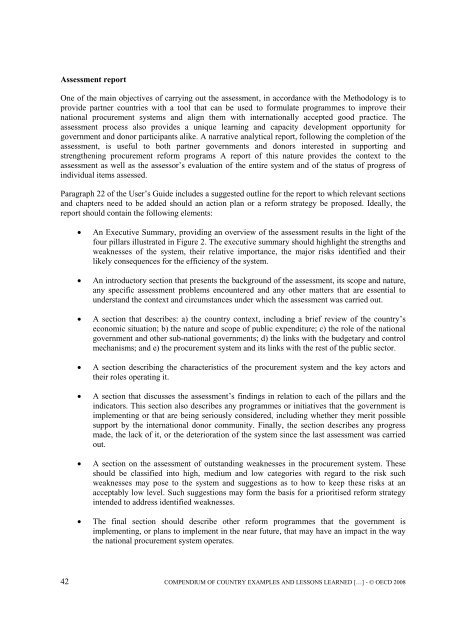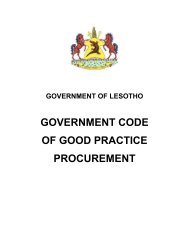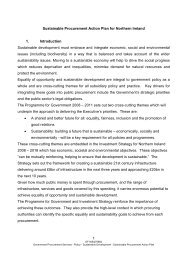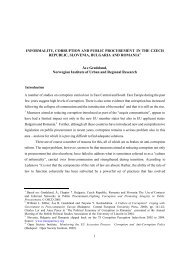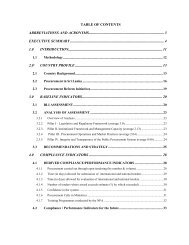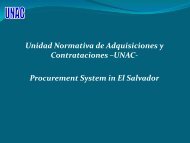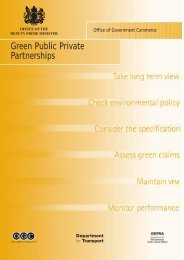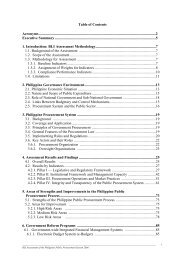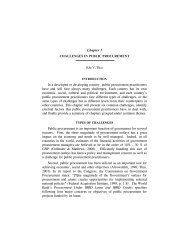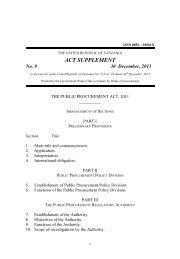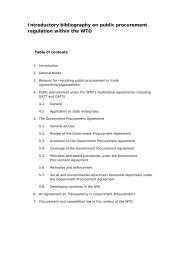Compendium of Country Examples and Lessons Learned from ...
Compendium of Country Examples and Lessons Learned from ...
Compendium of Country Examples and Lessons Learned from ...
You also want an ePaper? Increase the reach of your titles
YUMPU automatically turns print PDFs into web optimized ePapers that Google loves.
Assessment reportOne <strong>of</strong> the main objectives <strong>of</strong> carrying out the assessment, in accordance with the Methodology is toprovide partner countries with a tool that can be used to formulate programmes to improve theirnational procurement systems <strong>and</strong> align them with internationally accepted good practice. Theassessment process also provides a unique learning <strong>and</strong> capacity development opportunity forgovernment <strong>and</strong> donor participants alike. A narrative analytical report, following the completion <strong>of</strong> theassessment, is useful to both partner governments <strong>and</strong> donors interested in supporting <strong>and</strong>strengthening procurement reform programs A report <strong>of</strong> this nature provides the context to theassessment as well as the assessor‟s evaluation <strong>of</strong> the entire system <strong>and</strong> <strong>of</strong> the status <strong>of</strong> progress <strong>of</strong>individual items assessed.Paragraph 22 <strong>of</strong> the User‟s Guide includes a suggested outline for the report to which relevant sections<strong>and</strong> chapters need to be added should an action plan or a reform strategy be proposed. Ideally, thereport should contain the following elements:An Executive Summary, providing an overview <strong>of</strong> the assessment results in the light <strong>of</strong> thefour pillars illustrated in Figure 2. The executive summary should highlight the strengths <strong>and</strong>weaknesses <strong>of</strong> the system, their relative importance, the major risks identified <strong>and</strong> theirlikely consequences for the efficiency <strong>of</strong> the system.An introductory section that presents the background <strong>of</strong> the assessment, its scope <strong>and</strong> nature,any specific assessment problems encountered <strong>and</strong> any other matters that are essential tounderst<strong>and</strong> the context <strong>and</strong> circumstances under which the assessment was carried out.A section that describes: a) the country context, including a brief review <strong>of</strong> the country‟seconomic situation; b) the nature <strong>and</strong> scope <strong>of</strong> public expenditure; c) the role <strong>of</strong> the nationalgovernment <strong>and</strong> other sub-national governments; d) the links with the budgetary <strong>and</strong> controlmechanisms; <strong>and</strong> e) the procurement system <strong>and</strong> its links with the rest <strong>of</strong> the public sector.A section describing the characteristics <strong>of</strong> the procurement system <strong>and</strong> the key actors <strong>and</strong>their roles operating it.A section that discusses the assessment‟s findings in relation to each <strong>of</strong> the pillars <strong>and</strong> theindicators. This section also describes any programmes or initiatives that the government isimplementing or that are being seriously considered, including whether they merit possiblesupport by the international donor community. Finally, the section describes any progressmade, the lack <strong>of</strong> it, or the deterioration <strong>of</strong> the system since the last assessment was carriedout.A section on the assessment <strong>of</strong> outst<strong>and</strong>ing weaknesses in the procurement system. Theseshould be classified into high, medium <strong>and</strong> low categories with regard to the risk suchweaknesses may pose to the system <strong>and</strong> suggestions as to how to keep these risks at anacceptably low level. Such suggestions may form the basis for a prioritised reform strategyintended to address identified weaknesses.The final section should describe other reform programmes that the government isimplementing, or plans to implement in the near future, that may have an impact in the waythe national procurement system operates.42 COMPENDIUM OF COUNTRY EXAMPLES AND LESSONS LEARNED […] - OECD 2008


